
Toxicodendron is a genus of flowering plants in the sumac family, Anacardiaceae. It contains trees, shrubs and woody vines, including poison ivy, poison oak, and the lacquer tree. All members of the genus produce the skin-irritating oil urushiol, which can cause a severe allergic reaction. The generic name is derived from the Greek words τοξικός (toxikos), meaning "poison," and δένδρον (dendron), meaning "tree". The best known members of the genus in North America are poison ivy (T. radicans), practically ubiquitous throughout most of eastern North America, and western poison oak, similarly ubiquitous throughout much of the western part of the continent.
Sycamore is a name which has been applied to several types of trees, but with somewhat similar leaf forms. The name derives from the ancient Greek συκόμορος (sūkomoros) meaning "fig-mulberry".
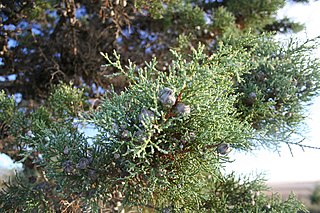
Cypress is a common name for various coniferous trees or shrubs of northern temperate regions that belong to the family Cupressaceae. The word cypress is derived from Old French cipres, which was imported from Latin cypressus, the latinisation of the Greek κυπάρισσος (kyparissos).

Live oak or evergreen oak is any of a number of oaks in several different sections of the genus Quercus that share the characteristic of evergreen foliage. These oaks are not more closely related to each other than they are to other oaks.

Limonium is a genus of 120 flowering plant species. Members are also known as sea-lavender, statice, caspia or marsh-rosemary. Despite their common names, species are not related to the lavenders or to rosemary. They are instead in Plumbaginaceae, the plumbago or leadwort family. The generic name is from the Latin līmōnion, used by Pliny for a wild plant and is ultimately derived from the Ancient Greek leimon.
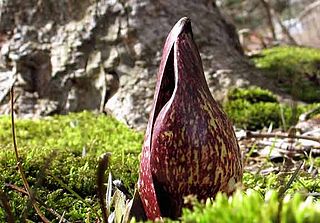
Symplocarpus foetidus, commonly known as skunk cabbage or eastern skunk cabbage, is a low growing plant that grows in wetlands and moist hill slopes of eastern North America. Bruised leaves present a fragrance reminiscent of skunk.

Leaf vegetables, also called leafy greens, salad greens, pot herbs, vegetable greens, or simply greens, are plant leaves eaten as a vegetable, sometimes accompanied by tender petioles and shoots. Although they come from a very wide variety of plants, most share a great deal with other leaf vegetables in nutrition and cooking methods.
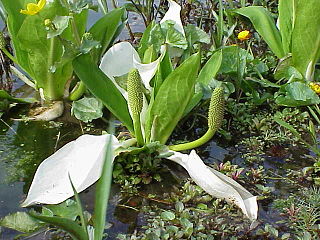
Lysichiton is a genus in the family Araceae. These plants are known commonly as skunk cabbage or less often as swamp lantern. The spelling Lysichitum is also found. The genus has two species, one found in north-east Asia, the other in north-west America.

Polecat is a common name for mammals in the order Carnivora and subfamilies Ictonychinae and Mustelinae. Polecats do not form a single taxonomic rank ; the name is applied to several species with broad similarities to European polecats, the only polecat species native to the British Isles.
Cabbage palm is a common name for several species of palms or palm-like plants:

The hog-nosed skunks belong to the genus Conepatus and are members of the family Mephitidae (skunks). They are native to the Americas. They have white backs and tails and black underparts.
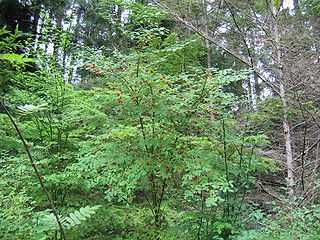
Vaccinium parvifolium, the red huckleberry, is a species of Vaccinium native to western North America, where it is common in forests from southeastern Alaska and British Columbia south through western Washington and Oregon to central California.

Veratrum is a genus of flowering plants in the family Melanthiaceae. It occurs in damp habitats across much of temperate and subarctic Europe, Asia, and North America.

Lysichiton americanus, also called western skunk cabbage (US), yellow skunk cabbage (UK), American skunk-cabbage or swamp lantern, is a plant found in swamps and wet woods, along streams and in other wet areas of the Pacific Northwest, where it is one of the few native species in the arum family. The plant is called skunk cabbage because of the distinctive "skunky" odor that it emits when it blooms. This odor will permeate the area where the plant grows, and can be detected even in old, dried specimens. The distinctive odor attracts its pollinators, scavenging flies and beetles. Although similarly named and with a similar smell, the plant is easy to distinguish from the eastern skunk cabbage, another species in the arum family found in eastern North America.

Orontioideae is a subfamily of flowering plants in the family Araceae. The subfamily consists of three genera namely, Lysichiton, Orontium, and Symplocarpus. Characteristics of Orontioideae include medium sized pollen grains and subterranean stems. Species in the subfamily have a base chromosome number of X=13.

Bluebell Arboretum is an arboretum and associated plant nursery near the village of Smisby in South Derbyshire, England. It is a Royal Horticultural Society recommended garden, comprising a large selection of rare trees, shrubs and climbers growing in a woodland garden. Planting was started by the owners, Suzette and Robert Vernon in 1992 on what was then a six acre meadow, just under 500 feet above sea level. The arboretum was officially opened by Roy Lancaster, OBE VMH in 1997, and has since been expanded and is now open to the public throughgout the year, excluding Sundays during the winter months.
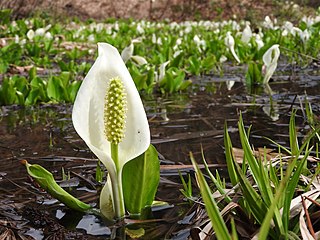
Lysichiton camtschatcensis, common name Asian skunk-cabbage or white skunk cabbage, is a plant found in swamps and wet woods, along streams and in other wet areas of the Kamchatka Peninsula, the Kuril Islands, Sakhalin and northern Japan. The common name "skunk cabbage" is used for the genus Lysichiton, which includes L. americanus, the western skunk cabbage, noted for its unpleasant smell. The Asian skunk cabbage is more variable: plants have been reported in different cases to smell disgusting, not at all, and sweet. In Japanese it is known as mizubashō from a supposed similarity to the Japanese banana, a name with poetic rather than malodorous associations. It is not closely related to the true cabbage.

Greasewood is a common name shared by several plants:
The Truttman Sink is an earthflow within the Humboldt Lagoons State Park, along the coast of Humboldt County, California. It is located between Trinidad to the south and Orick to the north. It deposits materials into the northern end of Big Lagoon and the Pacific Ocean, especially during periods of heavy rain. The soil characteristics, geology, and vegetation along the slope of this mass-wasting feature suggest a combination of an earthflow movement and a rotational slump.















